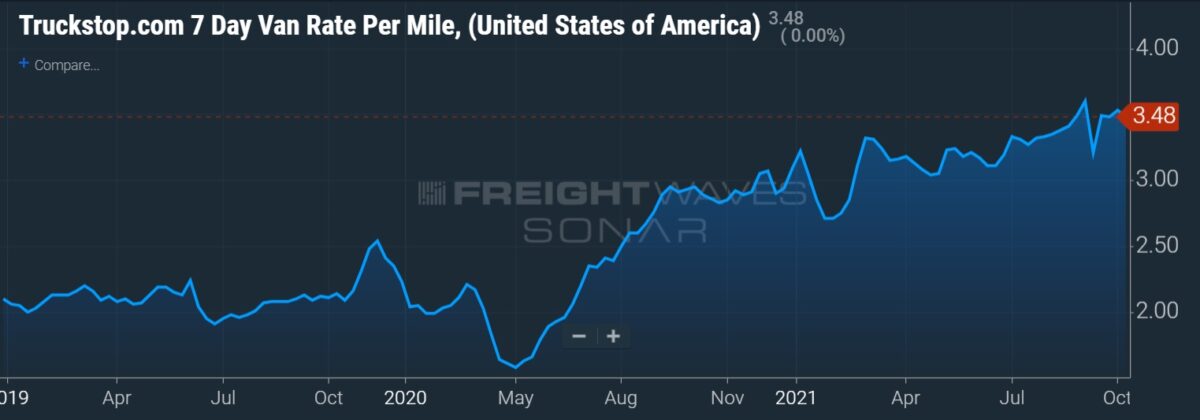September data from Cass Information Systems showed shipments fell victim to supply chain and capacity constraints while expenditures, a proxy for pricing, surged forward.
The shipments component of the Cass Freight Index (NASDAQ: CASS) slid 4.9% seasonally adjusted from August, according to the Wednesday report. The dataset was 0.6% higher than September 2020, which marked 12 straight months of year-over-year gains.
Some of the deceleration in freight volumes was pinned on Hurricane Ida and a worsening semiconductor shortage.
“Freight volumes also remain capacity-constrained, as shown by the armada of containerships at anchor off North American ports,” Tim Denoyer, senior analyst at ACT Research, commented. He believes a congested rail network is beginning to “unlimber a bit,” which could help the nation’s flow of freight. However, he sees intermodal volumes remaining constrained for some time due to chassis shortages and tariffs.
Cass’ expenditures subindex jumped higher again in September, up 32.2% year-over-year and almost 34% higher than the September 2019 reading. The growth rate comparisons to 2020 stiffened again in the month after peaking in June (+56.4%). The index declined 2.5% sequentially (seasonally adjusted) in September, just off of the record established in August.
| September 2021 | y/y | 2-year | m/m | m/m (SA) |
| Shipments | 0.6% | -1.3% | -4.1% | -4.9% |
| Expenditures | 32.2% | 33.8% | -0.4% | -2.5% |
| TL Linehaul Index | 12.7% | 8.9% | 1.1% | N/A |
The expenditures index measures total dollars spent to move freight and is impacted by changes in the number of shipments recorded each month. Shipments in September were down by a greater percentage than expenditures, implying freight rates stepped higher again during the month.
The report said the expenditures component is likely to record a full-year increase of 34% year-over-year if normal seasonality holds through 2021. Tougher comps during the fourth quarter have the expected growth rate slowing to plus-25%.
Inferred rates, or expenditures divided by shipments, climbed 31.4% year-over-year and 2.6% sequentially (seasonally adjusted) in September. The monthly uptick was on top of a 6.1% sequential increase in August. Higher fuel prices and air cargo rates, as well as less freight being moved by rail in favor of costlier trucking options, are driving expenditures higher.
Denoyer also noted an increase in excess miles “due to all of the supply chain disruptions in the shortage economy of 2021.” As examples, he pointed to “containers being offloaded at small remote ports to attempt to avoid the backlogs in LA and Long Beach, and chassis shortages pushing freight from the congested rail network onto truckload, considerably raising the length of haul in the largest freight market.”
Inferred rates grew almost 500 basis points faster year-over-year in September than in August.
Not surprisingly, Cass’ TL linehaul index was up 12.7% year-over-year, 1.1% higher sequentially. The index for linehaul rates (excluding fuel and assessorials) would be even higher but length of haul has increased, which drives the average of the per-mile rate lower.
The September level marks an all-time high for the linehaul index as a litany of headwinds face capacity. “Freight demand is clearly still strong, and supply challenges continue to mount, keeping upward pressure on rates,” Denoyer added.

“A skeptic might look at flattish volume and record rate increases and shout ‘Stagflation!’, but we would disagree,” Denoyer continued. “Freight demand is anything but stagnant and has been caged by supply constraints, which are likely peaking with the season.”
He thinks that supply chain easing could occur in the fourth quarter. He noted that intermodal volumes “have been inching up sequentially in recent weeks,” suggesting improving rail operations, and that power outages in China could allow the supply chain time to catch up with the containership backlog.
However, he sees low inventories and an early Chinese New Year, which starts Feb.1, as catalysts for elevated import demand into early 2022.
Even though the high-demand-tight-capacity dynamic “will not last indefinitely,” Denoyer said, “Freight demand fundamentals remain strong, based on a strong U.S. consumer balance sheet, inventory restocking and an industrial sector struggling to grow into record orders with infrastructure stimulus likely on the way.”
Data used in the Cass indexes is derived from freight bills paid by Cass, a provider of payment management solutions. Cass processes $26 billion in freight payables on behalf of more than 8,000 subscribers annually.







